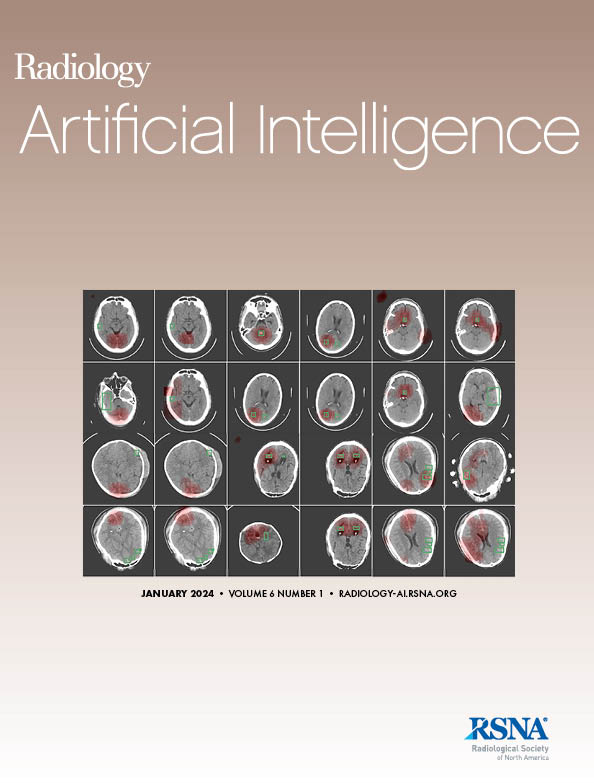Predicting Respiratory Disease Mortality Risk Using Open-Source AI on Chest Radiographs in an Asian Health Screening Population.
IF 13.2
Q1 COMPUTER SCIENCE, ARTIFICIAL INTELLIGENCE
Jong Hyuk Lee, Seung Ho Choi, Hugo J W L Aerts, Jakob Weiss, Vineet K Raghu, Michael T Lu, Jayoun Kim, Seungho Lee, Dongheon Lee, Hyungjin Kim
求助PDF
{"title":"Predicting Respiratory Disease Mortality Risk Using Open-Source AI on Chest Radiographs in an Asian Health Screening Population.","authors":"Jong Hyuk Lee, Seung Ho Choi, Hugo J W L Aerts, Jakob Weiss, Vineet K Raghu, Michael T Lu, Jayoun Kim, Seungho Lee, Dongheon Lee, Hyungjin Kim","doi":"10.1148/ryai.240628","DOIUrl":null,"url":null,"abstract":"<p><p>Purpose To assess the prognostic value of an open-source deep learning-based chest radiographs algorithm, CXR-Lung-Risk, for stratifying respiratory disease mortality risk among an Asian health screening population using baseline and follow-up chest radiographs. Materials and Methods This single-center, retrospective study analyzed chest radiographs from individuals who underwent health screenings between January 2004 and June 2018. The CXR-Lung-Risk scores from baseline chest radiographs were externally tested for predicting mortality due to lung disease or lung cancer, using competing risk analysis, with adjustments made for clinical factors. The additional value of these risk scores beyond clinical factors was evaluated using the likelihood ratio test. An exploratory analysis was conducted on the CXR-Lung-Risk trajectory over a 3-year follow-up period for individuals in the highest quartile of baseline respiratory disease mortality risk, using a time-series clustering algorithm. Results Among 36 924 individuals (median age, 58 years [IQR, 53-62 years]; 22 352 male), 264 individuals (0.7%) died of respiratory illness, over a median follow-up period of 11.0 years (IQR, 7.8-12.7 years). CXR-Lung-Risk predicted respiratory disease mortality (adjusted hazard ratio [HR] per 5 years: 2.01; 95% CI: 1.76, 2.39; <i>P</i> < .001), offering a prognostic improvement over clinical factors (<i>P</i> < .001). The trajectory analysis identified a subgroup with a continuous increase in CXR-Lung-Risk score, which was associated with poorer outcomes (adjusted HR for respiratory disease mortality: 3.26; 95% CI: 1.20, 8.81; <i>P</i> = .02) compared with the subgroup with a continuous decrease in CXR-Lung-Risk score. Conclusion The open-source CXR-Lung-Risk model predicted respiratory disease mortality in an Asian cohort, enabling a two-layer risk stratification approach through an exploratory longitudinal analysis of baseline and follow-up chest radiographs. <b>Keywords:</b> Conventional Radiography, Thorax, Lung, Mediastinum, Heart, Outcomes Analysis <i>Supplemental material is available for this article.</i> © RSNA, 2025 See also commentary by Júdice de Mattos Farina and Kuriki in this issue.</p>","PeriodicalId":29787,"journal":{"name":"Radiology-Artificial Intelligence","volume":" ","pages":"e240628"},"PeriodicalIF":13.2000,"publicationDate":"2025-05-01","publicationTypes":"Journal Article","fieldsOfStudy":null,"isOpenAccess":false,"openAccessPdf":"","citationCount":"0","resultStr":null,"platform":"Semanticscholar","paperid":null,"PeriodicalName":"Radiology-Artificial Intelligence","FirstCategoryId":"1085","ListUrlMain":"https://doi.org/10.1148/ryai.240628","RegionNum":0,"RegionCategory":null,"ArticlePicture":[],"TitleCN":null,"AbstractTextCN":null,"PMCID":null,"EPubDate":"","PubModel":"","JCR":"Q1","JCRName":"COMPUTER SCIENCE, ARTIFICIAL INTELLIGENCE","Score":null,"Total":0}
引用次数: 0
引用
批量引用
Abstract
Purpose To assess the prognostic value of an open-source deep learning-based chest radiographs algorithm, CXR-Lung-Risk, for stratifying respiratory disease mortality risk among an Asian health screening population using baseline and follow-up chest radiographs. Materials and Methods This single-center, retrospective study analyzed chest radiographs from individuals who underwent health screenings between January 2004 and June 2018. The CXR-Lung-Risk scores from baseline chest radiographs were externally tested for predicting mortality due to lung disease or lung cancer, using competing risk analysis, with adjustments made for clinical factors. The additional value of these risk scores beyond clinical factors was evaluated using the likelihood ratio test. An exploratory analysis was conducted on the CXR-Lung-Risk trajectory over a 3-year follow-up period for individuals in the highest quartile of baseline respiratory disease mortality risk, using a time-series clustering algorithm. Results Among 36 924 individuals (median age, 58 years [IQR, 53-62 years]; 22 352 male), 264 individuals (0.7%) died of respiratory illness, over a median follow-up period of 11.0 years (IQR, 7.8-12.7 years). CXR-Lung-Risk predicted respiratory disease mortality (adjusted hazard ratio [HR] per 5 years: 2.01; 95% CI: 1.76, 2.39; P < .001), offering a prognostic improvement over clinical factors (P < .001). The trajectory analysis identified a subgroup with a continuous increase in CXR-Lung-Risk score, which was associated with poorer outcomes (adjusted HR for respiratory disease mortality: 3.26; 95% CI: 1.20, 8.81; P = .02) compared with the subgroup with a continuous decrease in CXR-Lung-Risk score. Conclusion The open-source CXR-Lung-Risk model predicted respiratory disease mortality in an Asian cohort, enabling a two-layer risk stratification approach through an exploratory longitudinal analysis of baseline and follow-up chest radiographs. Keywords: Conventional Radiography, Thorax, Lung, Mediastinum, Heart, Outcomes Analysis Supplemental material is available for this article. © RSNA, 2025 See also commentary by Júdice de Mattos Farina and Kuriki in this issue.
在亚洲健康筛查人群胸片上使用开源AI预测呼吸系统疾病死亡风险
“刚刚接受”的论文经过了全面的同行评审,并已被接受发表在《放射学:人工智能》杂志上。这篇文章将经过编辑,布局和校样审查,然后在其最终版本出版。请注意,在最终编辑文章的制作过程中,可能会发现可能影响内容的错误。目的评估基于开源深度学习的胸片(CXR)算法(CXR - lung - risk)在亚洲健康筛查人群中使用基线和随访CXR对呼吸系统疾病死亡风险进行分层的预后价值。这项单中心回顾性研究分析了2004年1月至2018年6月期间接受健康筛查的个体的cxr。使用竞争风险分析,根据临床因素进行调整,对来自基线cxr的CXR-Lung-Risk评分进行外部测试,以预测肺部疾病或肺癌导致的死亡率。使用似然比检验评估这些风险评分超出临床因素的附加价值。使用时间序列聚类算法,对基线呼吸系统疾病死亡风险最高四分位数的个体在三年随访期间的CXR-Lung-Risk轨迹进行了探索性分析。结果36924例患者(中位年龄58岁[四分位数范围:53 ~ 62岁];22,352名男性),264人(0.7%)死于呼吸系统疾病,中位随访期为11.0年(四分位数范围:7.8- 12.7年)。CXR-Lung-Risk预测呼吸系统疾病死亡率(每5年校正危险比[HR]: 2.01, 95% CI: 1.76-2.39, P < .001),比临床因素提供预后改善(P < .001)。轨迹分析发现,与连续降低CXR-Lung-Risk的亚组相比,CXR-Lung-Risk持续增加的亚组与较差的预后相关(呼吸系统疾病死亡率调整HR: 3.26, 95% CI: 1.20-8.81, P = 0.02)。结论:开放源代码的CXR-Lung-Risk模型预测了亚洲队列的呼吸系统疾病死亡率,通过对基线和随访cxr的探索性纵向分析,实现了双层风险分层方法。©RSNA, 2025年。
本文章由计算机程序翻译,如有差异,请以英文原文为准。
来源期刊
期刊介绍:
Radiology: Artificial Intelligence is a bi-monthly publication that focuses on the emerging applications of machine learning and artificial intelligence in the field of imaging across various disciplines. This journal is available online and accepts multiple manuscript types, including Original Research, Technical Developments, Data Resources, Review articles, Editorials, Letters to the Editor and Replies, Special Reports, and AI in Brief.

 求助内容:
求助内容: 应助结果提醒方式:
应助结果提醒方式:


